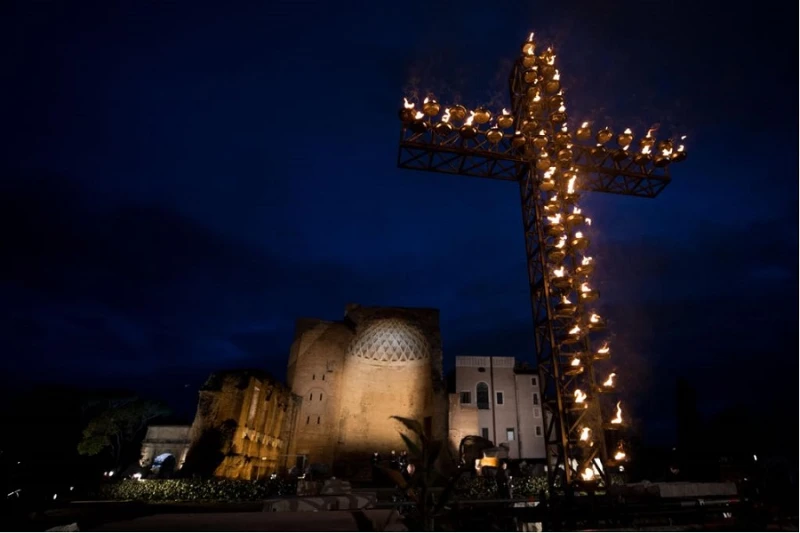
Denver Newsroom, Apr 14, 2022 / 15:07 pm (CNA).
Another Ukrainian bishop has voiced concern about the incorporation of both Russian and Ukrainian families into Pope Francis’ Way of the Cross devotional this Good Friday, noting that many Ukrainians have a hard time understanding this portrayal amid continued Russian aggression.
“In itself, this gesture of reconciliation is good, but its details may be incomprehensible and unacceptable to those who suffer now from the aggressor. This is why is such a strong reaction has arisen.” Bishop Vitaliy Kryvytskyi of Kyiv-Zhytomyr said in a message posted on Facebook April 12.
On Monday, the Vatican published the meditations and prayers for the pope’s Via Crucis, or the Way of the Cross. The devotional is scheduled to take place at the Colosseum in Rome, a practice dating back more than two centuries.
The Way of the Cross is a widespread Good Friday observance in Latin rite Catholic practice. The devotional takes inspiration from the gospels and Christian tradition, focusing meditation and reflection on fourteen scenes or “stations” in the last days of Christ, from his condemnation to death through his crucifixion and burial.
This year the pope’s Via Crucis which will focus this year on the “crosses” of family life. The thirteenth station, “Jesus dies on the Cross,” has a portrayal alluding to the recent Russian invasion of Ukraine. A Ukrainian family and a Russian family are due to read a reflection they wrote together about how their lives were upended by the pain of war.
Bishop Kryvytskyi is one of the several Latin rite bishops heading six dioceses and one archdiocese in Ukraine. They serve about 370,000 laity, about one percent of the total population. The Latin rite Catholic population is concentrated in the west of Ukraine and has cultural ties to Poland and Hungary.
The bishop lamented how reports of this portrayal have affected his fellow Ukrainians.
“I don’t want to be a judge to anyone, and I won’t be original when commenting on the scenario of the Way of the Cross on Good Friday at the Colosseum, where the cross should be carried jointly by Ukrainians and Russians,” he said, according to the Religious Information Service of Ukraine. “I share the opinion of many compatriots that the issue of its Thirteenth Station causes suffering rather than unites warring peoples, all the more because Russia does not stop its aggressive plans.”
At the Thirteenth Station, the Russian and Ukrainian families are expected to carry a wooden cross together in the Colosseum before passing it to a family of migrants, who will carry the cross for the final station.
“Why has my land become as dark as Golgotha? We have no tears left. Anger has given way to resignation,” the text of the reflection says. “Lord, where are you? Speak to us amid the silence of death and division, and teach us to be peacemakers, brothers and sisters, and to rebuild what bombs tried to destroy,” it continues.
The prayer following the meditation calls Christ’s pierced side a “wellspring of reconciliation for all peoples” and asks God that “families devastated by tears and blood may believe in the power of forgiveness.”
Bishop Kryvytskyi explained concerns and objections using the example of a joint replacement procedure. The procedure is not complex in itself but is complicated when the bone of the joint suffers from serious inflammation.
“A new joint is not something bad, but it will not fall into the desired place if the disease is not cured,” he said.
On April 12 Ukraine’s new ambassador to the Holy See, Andrii Yurash, said his embassy “understands and shares the general concern in Ukraine” about the portrayal. His embassy is trying to explain the “difficulties” and “possible consequences” of how the Way of the Cross in Rome incorporates the situation in Ukraine.
Major Archbishop Sviatoslav Shevchuck of Kyiv-Halych, head of the Ukrainian Greek Catholic Church, said the portrayal was “untimely,” “ambiguous” and “even offensive.” He worried that the decision “does not take into account the context of Russia’s military aggression against Ukraine.”
Bishop Kryvytskyi’s commentary on Facebook included a photo of Michelangelo’s Pieta.
“It seems to me that over the past 24 hours, I have done everything possible to convey the inconsistency of this liturgical gesture in the context of the terrible war and its planned possible escalation,” he said.
“I give the rest to God. I am also convinced that I did everything possible on my own behalf not to say an unnecessary word of condemnation in the direction of those who did not fully weigh all the circumstances.”
“I made a mistake trying to make my own efforts to stop the war. I sincerely hope that the organizers will still have the opportunity to correct the scenario of the Way of the Cross and avoid further disputes on this topic,” said the bishop.
Ukraine’s 44.1 million people are predominantly Eastern Orthodox, though about nine percent, about 3.6 million people, are Greek Catholics, belonging to Churches of the Byzantine rite in communion with Rome.
Catholic Churches were severely persecuted in Ukraine when the country was part of the Soviet Union. The renewal of conflict between Russia and Ukraine in the 2010s brought with it fears of ecclesial conflict and persecution.
The Russian invasion of Ukraine began Feb. 24. Russia has tried to justified the invasion with claims military forces were needed to “de-militarize” the country, to protect Russian speakers in eastern Ukraine, and to prevent Ukraine from further integration with the defensive NATO alliance, among other reasons. Russia’s government has tried to avoid describing the invasion as a war.
Ukraine’s government and its supporters strongly reject Russia’s claims.
Since the invasion, more than 1,800 civilians have been killed, with numbers expected to rise as deaths are confirmed. Millions more people have been forced to flee their homes and thousands of military combatants have also died in the fighting.
If you value the news and views Catholic World Report provides, please consider donating to support our efforts. Your contribution will help us continue to make CWR available to all readers worldwide for free, without a subscription. Thank you for your generosity!
Click here for more information on donating to CWR. Click here to sign up for our newsletter.





One possibly perceptive way of understanding what is truly incomprehensible (the carrying of the Cross by two Russian and Ukrainian women) might be something like this…
What if, instead of plastering the event with the specious imagery of reconciliation, the message instead is about the immediate victimization of families East and West by a spiritual descendant of Genghis Kahn, plus his buddy oligarchs…
That is, what if at this moment in history the issue is real “families,” a central element of the Catholic Social Teaching (although not mentioned as such in the paperwork behind synodality)? And, what if the issue is real “motherhood,” as when the Virgin Mother of God accepted her own (!) crucifixion by accepting the words of Simeon, about a sword through her own heart, when the incarnate Christ was first taken to the Temple?
What if the underlying issue is not whether the sinking Vatican might still maneuver toward some kind of role in mediation toward reconciliation? What if the issue is not the Secretariat of State, but rather the dicastery for the Doctrine of the Faith (and morals as now explicitly under Veritatis Splendor, nn. 95, 115!).Is there a convincing precedent for bridge-building by the selection of less glib and truly fecund wording?
Yes, but it is not the double-speak of Amoris Laetitia (the waffling Chapter 8 and its notorious footnote 351), or even the cautious understating/marginalization (?) in world affairs of Revelation to the very promising but incomplete concept of “fraternity.”
Instead, we might be reminded of Chapter One of John’s Gospel. The evangelizing John lands on the term “Logos” as one that captures both the Jewish understanding of Revelation and the Greek understanding of Reason. Christ as Logos! But this inspired framing of Revelation fits only because the incarnate Christ, in absolute truth and historical fact, is actually the union of the divine nature and the human nature in one Person, the former elevated into the eternal Second Person of the Triune Oneness. As St. Augustine thru Newman explain—-we believe in a Trinity, not a quaternary (or, do we still?).
So, the pope might be onto something if he explained that he is handing the cross to two real women and to two real families. Not to the postured and therefore incomprehensible vocabulary of reconciliation. Not now.
A camel is a horse designed by a committee. Too many ungrounded speech writers who think it’s mostly about mediating a win-win middle ground between equivalent interests, or between convoluted positions and counter-positions—and not about binary good and evil.
Just some thoughts, here, from the back bleachers. But, why be rigid? Why be bigoted? Who am I to judge?
On second thought, I have misspoken. In the fourth paragraph, instead of “glib,” perhaps the correct word is facile, or oblique, or maybe uncomprehending.